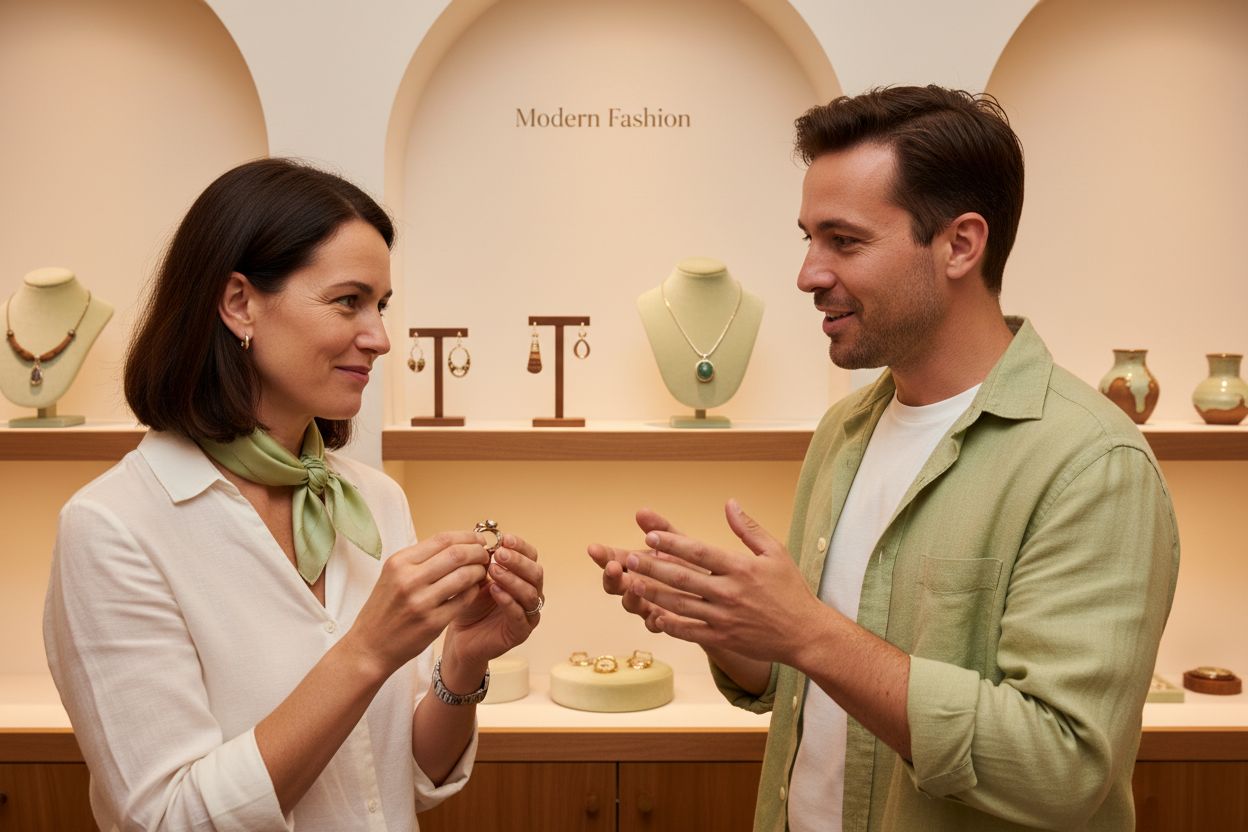Artisan jewelry is everywhere right now and you might notice it looks nothing like what you find on department store shelves. Mass production can spit out thousands of identical necklaces in a single day but each true artisan piece is as unique as a fingerprint. In fact, some artisan jewelers make fewer than 50 pieces per year, turning their work into something far rarer than gold itself. This shift means jewelry is no longer just an accessory but a bold personal statement and a story you actually get to wear.
Table of Contents
- Defining Artisan Jewelry: What Sets It Apart?
- The Significance of Artisan Jewelry in Modern Fashion
- Craftsmanship and Materials: How Artisan Jewelry Is Made
- The Impact of Artisan Jewelry on Sustainability and Ethics
Quick Summary
| Takeaway | Explanation |
|---|---|
| Artisan jewelry embodies unique creativity. | Each piece is handcrafted, showcasing the artisan’s individual skills and artistic expression, unlike mass-produced items. |
| Sustainability is a key attribute. | Artisan jewelry production focuses on minimizing environmental impact through limited batch production and the use of recycled materials. |
| Support ethical consumption. | Choosing artisan jewelry contributes to fair economic practices, empowering artisans and preserving traditional crafting methods in their communities. |
| Each piece tells a story. | Artisan jewelry reflects cultural heritage and personal narratives, turning simple materials into meaningful wearable art. |
| Consumer values have shifted. | Modern buyers prefer authentic and unique items that represent social responsibility and individual values over conventional fashion trends. |
Defining Artisan Jewelry: What Sets It Apart?
Artisan jewelry represents a profound celebration of individual creativity, traditional craftsmanship, and personal artistic expression. Unlike mass-produced accessories, these unique pieces embody the maker’s skills, cultural heritage, and meticulous attention to detail. Handcrafted jewelry distinguishes itself through intimate production processes where each piece tells a distinctive story.
The Essence of Artisan Craftsmanship
At its core, artisan jewelry is characterized by several fundamental qualities that separate it from commercial manufacturing. These distinctive attributes include:
![]()
- Personal Creation: Each piece is individually designed and crafted by a skilled maker
- Limited Production: Small batch or one-of-a-kind designs that ensure exclusivity
- Direct Maker Involvement: The artisan controls every stage of jewelry production
The artisan’s hands transform raw materials like precious metals, gemstones, and unique elements into wearable art. Their techniques often blend traditional methods passed through generations with contemporary design sensibilities, creating pieces that are simultaneously timeless and modern.
Techniques and Artistic Expression
Artisan jewelry makers employ a range of specialized techniques to create their distinctive pieces. These might include hand hammering metals, intricate wire wrapping, traditional metalsmithing, or incorporating unconventional materials like recycled elements or locally sourced stones. Learn more about our custom jewelry collections to appreciate the depth of artisan craftsmanship.
Each jewelry piece becomes a narrative of skill, cultural context, and personal artistic vision. The maker’s unique perspective transforms simple materials into extraordinary wearable art that connects the wearer with a deeper sense of creativity and human expression.
The Significance of Artisan Jewelry in Modern Fashion
In contemporary fashion landscapes, artisan jewelry has emerged as a powerful statement of personal style, ethical consumption, and cultural appreciation. Recent consumer trends demonstrate a growing preference for unique, handcrafted pieces that transcend traditional mass-produced accessories.
Shifting Consumer Values
The rising popularity of artisan jewelry reflects profound changes in consumer consciousness. Modern buyers increasingly seek products that represent more than aesthetic appeal. These conscientious consumers value:
- Authenticity: Genuine stories and personal connections behind each piece
- Sustainability: Reduced environmental impact through limited production
- Ethical Manufacturing: Supporting individual artisans and their communities
This shift signals a deeper understanding that fashion can be a form of meaningful personal expression and social responsibility. Artisan jewelry becomes a vehicle for communicating individual values and supporting global craftsmanship.
Cultural Preservation and Global Connections
Beyond fashion trends, artisan jewelry serves as a critical medium for preserving cultural heritage and fostering global understanding. Each piece carries intricate design techniques, traditional symbolism, and generational knowledge. Explore our contemporary jewelry collections to witness how traditional craftsmanship meets modern design sensibilities.
By choosing artisan jewelry, wearers participate in a global narrative of creativity, respect for traditional skills, and appreciation for human artistic expression. These pieces are not merely accessories but wearable artifacts that connect individuals across geographical and cultural boundaries.

Craftsmanship and Materials: How Artisan Jewelry is Made
The creation of artisan jewelry represents an intricate dance between skilled craftsmanship and carefully selected materials. Traditional jewelry-making techniques showcase the profound expertise required to transform raw materials into wearable art, with each piece reflecting the artisan’s unique vision and technical mastery.
Material Selection and Sourcing
Artisan jewelry begins with meticulous material selection. Craftsmen prioritize quality and authenticity, often choosing materials that tell a story or connect to specific cultural traditions. Key considerations in material selection include:
- Precious Metals: Carefully sourced silver, gold, and platinum
- Gemstones: Hand-selected stones with unique characteristics
- Sustainable Materials: Recycled metals or ethically sourced elements
This deliberate approach ensures that each piece not only looks beautiful but also carries intrinsic value beyond its aesthetic appeal. The materials themselves become a narrative of origin, craftsmanship, and artistic intention.
The following table summarizes the primary materials and techniques artisan jewelers use, highlighting their significance and role in the creation process.
| Component | Description | Significance |
|---|---|---|
| Precious Metals | Gold, silver, and platinum selected for quality and authenticity | Provide intrinsic value and durability |
| Gemstones | Hand-selected stones with unique character | Enhance individuality and artistic intent |
| Sustainable Sources | Recycled metals, ethically sourced materials | Minimize environmental impact |
| Techniques | Hand hammering, wire wrapping, metalsmithing, stone setting | Demonstrate skill and allow for creativity |
| Production Scale | Limited batches or one-of-a-kind pieces | Ensures exclusivity and personal value |
Techniques and Transformation
Artisan jewelry making involves a range of specialized techniques that transform raw materials into intricate designs. These methods often combine centuries-old traditions with contemporary innovation. Techniques might include hand hammering, intricate wire wrapping, metal casting, and precise stone setting. Explore our fine jewelry collections to witness the nuanced craftsmanship behind each unique piece.
Each piece represents hours of dedicated work, with artisans using specialized tools and techniques passed down through generations. The result is not just a piece of jewelry, but a testament to human creativity, skill, and artistic expression that transcends mere ornamentation.
The Impact of Artisan Jewelry on Sustainability and Ethics
Artisan jewelry has emerged as a powerful catalyst for ethical consumption and environmental responsibility in the fashion industry. Sustainable craftsmanship practices demonstrate how individual creativity can intersect with global environmental and social considerations.
Environmental Sustainability
The production of artisan jewelry fundamentally challenges traditional mass manufacturing models by embracing sustainable practices. This approach significantly reduces environmental impact through:
- Limited Production: Minimizing waste and overconsumption
- Recycled Materials: Repurposing metals and gemstones
- Low Carbon Footprint: Reducing industrial manufacturing emissions
By prioritizing quality over quantity, artisan jewelers create pieces that are not just accessories but conscious statements about environmental stewardship. Each handcrafted piece represents a commitment to reducing the fashion industry’s ecological burden.
Ethical Community Impact
Beyond environmental considerations, artisan jewelry plays a critical role in supporting global crafting communities. These small-scale production models provide direct economic opportunities for skilled artisans, particularly in regions with limited industrial infrastructure. Explore our sustainable jewelry collections to understand how conscious consumption can create meaningful change.
The ethical dimensions of artisan jewelry extend far beyond the finished product. By choosing these pieces, consumers actively participate in a global movement that values human skill, preserves traditional crafting techniques, and supports fair economic practices that empower individual makers.
Elevate Your Story With Authentic Artisan Craftsmanship
Searching for jewelry that truly reflects individual artistry instead of mass production? Many are drawn to artisan jewelry because they crave authenticity, artistry, and meaningful personal connection in what they wear. You want jewelry made with real care by dedicated craftspeople, using quality materials like 14k gold, sterling silver, and hand-selected gemstones. If you are inspired by the unique details and human story behind every piece discussed in our article, discover how artisan values are brought to life in every collection at Malibu Vibes Jewelry.

Every piece in our Bezel Jewelry Collection is handcrafted in Los Angeles by skilled artisans. This means you are not just buying jewelry, but wearable art made to last and express your style. Visit Malibu Vibes Jewelry today to shop curated, limited-edition artisan jewelry and experience the satisfaction of owning something truly special. Embrace your individuality now by choosing craftsmanship over convention.
Frequently Asked Questions
What is artisan jewelry?
Artisan jewelry refers to handcrafted accessories that are created by skilled makers, emphasizing individual creativity and traditional craftsmanship. Each piece is unique and often tells a personal story.
How is artisan jewelry different from mass-produced jewelry?
Unlike mass-produced jewelry, artisan jewelry is typically made in small batches or as one-of-a-kind pieces. It involves direct maker involvement in every stage of production, resulting in exceptional quality and uniqueness.
To help you quickly see how artisan jewelry stands apart from mass-produced pieces, the table below compares their key characteristics and approaches.
| Aspect | Artisan Jewelry | Mass-Produced Jewelry |
|---|---|---|
| Production Method | Handcrafted individually by skilled artisans | Manufactured in large quantities by machines |
| Uniqueness | Each piece is unique, often one-of-a-kind or limited edition | Identical copies, little to no individuality |
| Materials Used | Carefully selected, often recycled or ethically sourced | Commonly standard, sometimes lower-grade materials |
| Maker Involvement | Direct artisan involvement in all stages | Minimal or no personal involvement by makers |
| Environmental Impact | Lower, due to small batch production and recycling | Higher, due to mass production and waste |
| Artistic Expression | Personal vision and story reflected in design | Follows current fashion trends, less creative input |
| Community Benefit | Supports local artists and traditional craft communities | Primarily benefits large corporations |
What materials are commonly used in artisan jewelry?
Artisan jewelry often features high-quality materials such as precious metals (like gold and silver), unique gemstones, and sustainable or recycled elements, all carefully selected for their intrinsic value and significance.
Why is artisan jewelry considered more sustainable?
Artisan jewelry promotes sustainability by embracing limited production, reducing waste, and often using recycled materials. This approach minimizes the environmental impact associated with mass manufacturing processes.
Recommended
- What is Fine Jewelry? Understanding Luxury and Craftsmanship – Malibu Vibes Jewelry
- What is Custom Jewelry? Understanding Unique Creations – Malibu Vibes Jewelry
- Understanding What is Contemporary Jewelry for Today’s Fashion – Malibu Vibes Jewelry
- What is Minimalist Jewelry? Understanding Its Beauty and Significance – Malibu Vibes Jewelry



